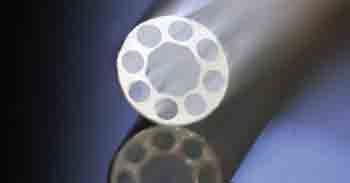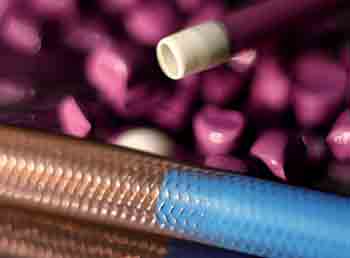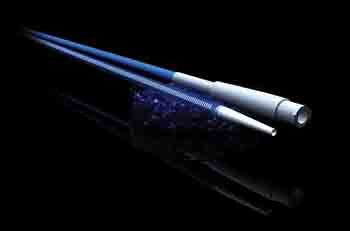A Deeper Look into Lumens
As today’s medical technology advances, physicians expect minimally invasive surgical devices to perform an array of sophisticated procedures, while delivering an ever-increasing level of performance. At the same time, medical device designers must continually strive to minimize the profile of the system for enhanced access to the target anatomy.
January 27, 2011
Today’s medical device engineers must understand the advances and limitations of tubing technology as defined by both the extrusion process and postextrusion technology in order to take advantage of the best designs and ensure the success of their products. As a growing number of procedures take advantage of minimally invasive techniques and technologies, expect to see a wider array of devices that incorporate these features.
Examples of markets that rely heavily on tubing technology include the following:
Neurovascular (e.g.,treatment of stroke).
Cardiovascular (e.g., angioplasty, stenting, cardiac ablation, and mitral valve repair).
Peripheral interventions (e.g., stent grafts, venous therapy).
Implants (e.g, inferior vena cava filter, patent foramen ovale treatment, and prosthetics valves).
The requirements of tubing for such sophisticated devices are varied. In general, device engineers need tubes to be smaller, perform better, and have more-varied functions than in the past.
Make Them Smaller. No longer will a single-lumen microbore tube suffice for medical applications. Of course, tubes need to stay the same microdiameter but now require multiple lumens (more than one hole). Multiple lumens are designed to achieve a desired performance in the smallest space possible. Engineers commonly ask for tubing that has an outer diameter of 0.03 in. with three and sometimes six or more lumens required for device functionality. For example, with neurovascular devices designed to reach the brain for treatment, the catheter and delivery system require microdiameter extrusions with precisely controlled walls.
|
|
High Performance Is Essential. When requirements for an extruded tube are beyond the physical capability of thermoplastic polymers, reinforcements such as braiding or coiling of the outer or inner diameter can be introduced to increase performance. Characteristics such as bend radius, flexibility, and stiffness can be enhanced with the proper filament and pitch configuration of the braid or coil. Large, ultra-thin-wall tubing with greater kink resistance plays an ever-increasing role in cardiovascular devices. Being able to deliver dilators through a tough yet flexible sheath is a common requirement.
Introduce Fluid Transfer and Inflation Characteristics. Many intravascular devices now require complex multiple-lumen tubes to accommodate the multitude of tasks they are expected to perform. For instance, microdiameter tubing makes it possible to flush a catheter and inflate a balloon within one device. This advance in tubing technology and the available geometries help make the devices for these surgeries as minimally invasive as possible. Two to 12 lumens can be designed into a single tube to provide multiple activities through a single access port. Some of these multiple-lumen tubes require the same performance as single-lumen tubes. Filament-reinforced multiple-lumen tubes are developed for such applications.
Navigate Tortuous Anatomy with Kink Resistance. A catheter’s ability to move nimbly and precisely through tortuous anatomy requires both great flexibility and a fair amount of stiffness so that the physician can push the catheter to the intended part of the anatomy. Coil-reinforced tubing is commonly used to help achieve these characteristics. Thin-wall tubing is generally required for such delivery systems. The use of thin walls in medical tubing increases the usable space inside the tube, allowing more complicated devices to be delivered, while the outer diameter maintains an intended diameter (18 French for instance). The problem with thin-wall tubing is that it is more prone to kinking early on, which could render the device useless. Reinforcing the thin-wall tube with a filament in a particular configuration can increase the degree to which the tube can bend before kinking.
Tubing Attributes
To meet the requirements for new applications, designers are asking tubing manufacturers to solve various challenges. These challenges are being met through various production and postproduction methods (see Table I).
Torque Response. Catheters in use today require a high degree of torque (the ability to twist the catheter) inside the patient for catheter guidance. This twisting occurs from the physician’s access point. The degree of torque the catheter is required to go through depends on the application. With filament-reinforced tubing in a braided pattern, a designer can achieve maneuverability without compromising the integrity of the catheter.
|
|
Deflection. Guide lumens can be included in the design of tubing to assist with the deflection or steering of a catheter. With lumens strategically positioned, pull wires can be incorporated into the tubing for control of the tip of the catheter. This control assists with the delivery of catheter systems with greater accuracy and ease of maneuverability for the physician.
Coatings and Lubricity. Some applications require that a tube slide against another tube, such as a dilator against its sheath. In such applications, a lubricious coating can be applied to the tube to decrease the friction that naturally occurs between most thermoplastic resins. Coatings can help produce a catheter system with a lower coefficient of friction, making the catheter easier to deliver. The benefit is that tighter clearances can be designed into the tubing, making walls thinner or the tubing smaller. Materials must be selected that can be processed to accept some form of coating. Etched polytetrafluoroethylene (PTFE) liners can also be added to the inner diameter of tubing for lubricity. In most cases, liner etching allows the bonding layer of material to adhere to the PTFE. It should be noted that fluoropolymers should be verified for compatibility with the specified method of sterilization, because gamma radiation could affect the mechanical properties of some polymers.
Bondable. Catheter applications require the tubing to bond to something, whether it is a catheter that is bonded to a balloon or a catheter that is bonded to its hub. The material used in the tubing design must be bondable but still perform as intended. Components can be bonded in a variety of ways, such as by thermal bonding, solvent bonding, or ultrasonic welding. The tubing material used in a particular bonding application must be able to withstand the effects of the chosen bonding technique.
Multiple Lumens. For tubing to perform a multitude of tasks, multiple lumens must be designed into the tubing. These lumens can serve as inflation ports, fluid-transfer channels, guidewire access points, or even steering lumens. Proper design of the multiple-lumen tubing must be taken into consideration. Properly dimensioned drawings that are well balanced make for better performing catheters later on. Multiple-lumen tubes can also be braided or coiled for additional performance. The outer diameter of the tubing is the most commonly braided feature of tubing. With recent advances in technology, a single lumen within a multiple-lumen tube can now have a braid added to it. This enhancement adds a whole new level of sophistication to the tubing process.
What Is Possible?
Depending on the application, 12 lumens can be extruded within a single tube. Lumens are no longer expected to be round, and eccentric shapes (oblong or crescent for example) are becoming more common. Multiple-lumen tubing with profile outer diameters contouring to the pattern of the lumens can also be designed in.
|
Table I. Advantages and disadvantages associated with extrusion design features. |
As with single-lumen tubing, the walls within a multiple-lumen tube can be as thin as 0.001 in., depending on the material selection and its capability to sustain that level of wall thickness. Thin walls produce larger inner diameters, allowing the engineer to do more with a limited outer diameter. Care must be exercised when specifying thin walls, ensuring the final device design’s integrity is not jeopardized.
In the design of multiple-lumen tubing, one of the features to avoid is sharp corners, because thermoplastic polymers do not fill corners of tooling well. It is also important to keep the tubing symmetrically balanced to ensure polymer flow through the extrusion process. In most cases the performance of the tubing can also increase with balanced wall thickness. Such balance enables proper manipulation through a patient’s anatomy.
Braiding and Coiling
The level of performance of either a braid or a coil depends on its configuration. Special winding techniques that incorporate pull-wire lumens surround the reinforcing filaments and can lead to strong, thin-walled, deflectable catheters. The techniques result in optimized performance by maximizing the working channel-to-wall ratios. Through such techniques, designers can introduce zero-angle elements of various specialized components including carbon fiber, Kevlar, or spectra (for antistretch or a bright radiopaque line—ability to see the tube under fluoroscopy—down the shaft).
Braiding is best for torque response and burst pressure. Electronically controlled computer software helps to control the braid configuration. It also allows repeatable variable braid angles and pics per inch (number of filament crossings) throughout the shaft to optimize the catheter’s hoop strength for kink resistance at the distal end. A lower braid angle can be used for torque and push at the proximal end of the shaft. Computer controlled software provides a continuous smooth transition between the distal and proximal segments for optimal performance.
Some advanced braiding techniques enable compression loads to increase, but resist buckling during excessive compression loading of retrievable devices such as stent grafts, filters, heart valves, and other implantable devices. Increasing the number of filaments increases the tubing’s radial strength, thereby increasing the amount of pressure the tubing can handle before bursting.
The number of carriers used in braiding tubing varies depending on the application. These carriers refer to the number of spools with braiding filaments on them. The common numbers of carriers used in braiding are 16, 24, 32, or 48. Generally, the more braiding filament used, the tighter the braid will be. Braid patterns are created by electronically controlling the pitch of the filament and the braiding filament gauge size and shape (e.g., round or flat). The patterns created using braiding techniques include a standard 1 over 2 under 2, diamond pattern, or a 1 over 1 under, for example. These patterns can vary down the length of a single shaft to increase or decrease the flexibility or stiffness of the tubing being braided. Common filaments used in braiding including stainless steel, nitinol, Kevlar, fiberglass, carbon fiber, and PET.
Coiling is better for kink and crush resistance. Kink resistance is defined by how tight a radius the tubing can go through before it kinks. Tubes with thin walls are highly susceptible to kinking early on. Adding a coil and controlling the angle at which the filament is laid down determines how much of an increase the tube’s radius will be. To increase the tube’s resistance to being crushed, a coil of filament is added to the tubing. The same filaments used in braiding are often found in coiling applications.
Conclusion
Catheters used in medical devices designed today are more sophisticated than ever, increasing the challenge of designing tubing that can meet such rigorous requirements. There are several advanced technologies in tubing and postextrusion processing for catheter design engineers to take advantage of, including braiding, coiling, and multiple-lumen tubing. Braiding and coiling can improve performance in medical device applications by increasing torque force or the bend radius of a tube.
There has been an increase in the number of tubing manufacturers providing tubing to the medical industry over the last 10 years. Designing and developing complex multiple-lumen tubing can spur innovation, provided that the designer understands the latest technology and how best to work with a tubing manufacturer.
Matthew Bills is director of extrusion technology at Duke Empirical (Santa Cruz, CA).
About the Author(s)
You May Also Like







